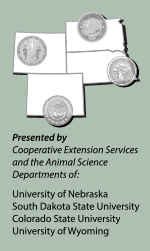Current Trade Issues
Exports are the new frontier for the beef industry.
by Kasey Brown, associate editor
RAPID CITY, S.D. (Dec. 3, 2014) — “New money in the industry is coming from the trade side. Seventeen percent of the money that is paid for our cattle comes from some other currency,” said Gregg Doud, president of Commodity Markets Council, as he addressed more than 500 participants of the 23rd Range Beef Cow Symposium Dec. 3-5, 2013, in Rapid City, S.D.

Exports are the new frontier for the beef industry, said Gregg Doud, president of Commodity Markets Council.
The biggest economic changes of the past decade are the increased buying power of consumers all over the world, said Doud, encouraging ranchers not to get hung up on declining per capita domestic beef consumption. Customers now are global, especially with the emergence of trans-Pacific partnerships (TPPs).
TPPs act as a wagon wheel, Doud explained. The TPP network serves as the hub and spoke mechanisms for everyone involved, so everyone enjoys tariff-free trade. He said trade agreements generally take about three to five years to really take effect, and South Korea is a prime example. With a TPP, tariffs have to eventually go to zero, and the negotiations determine how long it takes to get there.
With South Korea, the United States and Australia compete head-to-head. With the negotiation in effect, 2014 (the second year of the TPP in effect) will have a 32% tariff on U.S. beef as opposed to the 40% tariff on beef from everyone else. This means that U.S. beef will be tariffed 8% less than Australian beef. That is significant enough that Meat & Livestock Australia (MLA) has closed its South Korean office.
There are other large areas of growth, but Greater China shows the most promise, he said. There are 1.5 billion pounds (lb.) more beef going to China/Hong Kong this year vs. last year. To put that into perspective, Wal-Mart’s domestic beef sales are just more than 2 billion lb., and the United States imports about 2.2 billion lb.
During the past two years, beef prices in China have increased 83%. The retail price of beef in China is now $4.80 per lb. It is currently $4.95 per lb. in the United States, he noted. U.S. short ribs and chuck rolls — the staple in South Korea and Japan — used to be out of the price range for middle-class Chinese consumers. That is no longer the case, and Doud said that is one of the biggest things to happen to ranchers all around the world.
He illustrated that Chinese incomes are roughly one-sixth of U.S. incomes, so our average price of $4.80 per lb. translates to $28 per lb. in China, yet demand is growing. The added value that the export markets add to a beef carcass may be in its infancy and could grow exponentially.
Growth in Asia has been impressive, but the European Union’s (EU) non-tariff trade barriers to block imports are still frustrating, he said. The United States is actually selling in excess of a quarter of a billion dollars worth of beef to the EU, because the EU became a net beef importer rather than exporter in 2003. There are still hormone-free barriers, though.
U.S. beef faces sanitary and phytosanitary issues (food safety and animal and plant health measures) around the world, said Doud, noting two points:
- (1) We are usually our worst enemy. Once a politician says something, it is incredibly hard to take back. Other countries pay attention.
- (2) Scaring people makes for good fundraising within the activist community.
Doud said he deals with beta-agonists and genetically modified organisms (GMOs) currently, but emphasized that ranchers must be able to articulate the reasons for growth technology. He warned about future issues with animal welfare and antibiotics.
In the past 10 years, export markets have been rebuilt from scratch. Current international markets are diversified, and they provide new sources of revenue in addition to providing a solid foundation for current price levels.
Doud spoke Tuesday at RBCS XXIII. Visit the Newsroom at www.rangebeefcow.com/2013 view read his proceedings paper or listen to his presentation.
---------------------
The RBCS is a biennial educational symposium offering practical production management information. It is sponsored by the Cooperative Extension Service and animal science departments of the University of Wyoming, South Dakota State University, Colorado State University and the University of Nebraska.
Comprehensive coverage of the symposium is available online at www.rangebeefcow.com. Compiled by the Angus Journal editorial team, the site is made possible through sponsorship of LiveAuctions.tv and the cooperation of the host committee.
Editor’s Note: This article was written under contract or by staff of the Angus Journal. To request reprint permission and guidelines, contact Shauna Rose Hermel, editor, at 816-383-5270.


